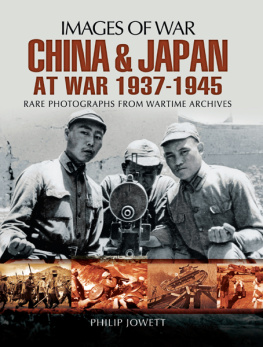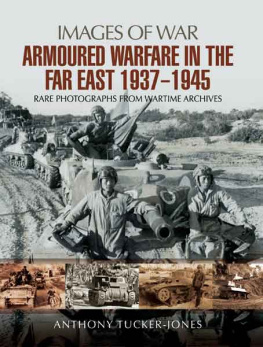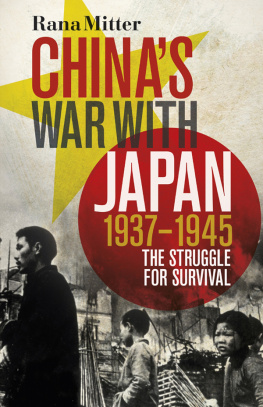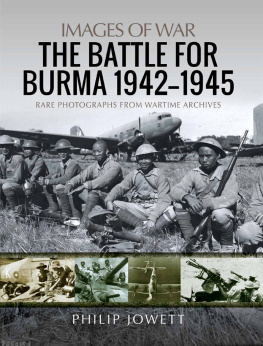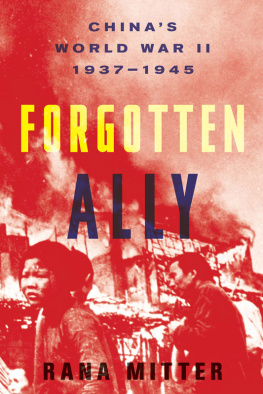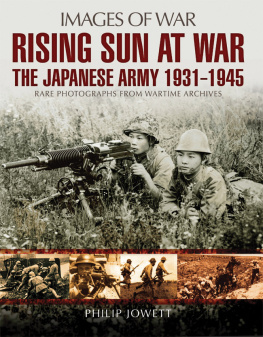
This stylized illustration from the cover of a French magazine published in October 1937 depicts a resolute Nationalist Chinese soldier looking into the distance. The caption says that this is a typical Chinese soldier fighting against the Japanese in defence of Shanghai. World opinion was generally on the side of the Chinese in 1937 as they were seen as victims of Japanese aggression.
First published in Great Britain in 2016 by
PEN & SWORD MILITARY
an imprint of
Pen & Sword Books Ltd,
47 Church Street,
Barnsley,
South Yorkshire
S70 2AS
Text copyright Pen and Sword Books, 2016
Photographs copyright as credited, 2016
Every effort has been made to trace the copyright of all the photographs. If there are unintentional omissions, please contact the publisher in writing, who will correct all subsequent editions.
A CIP record for this book is available from the British Library.
ISBN: 978 1 47382 752 3
PDF ISBN: 978 1 47387 442 8
EPUB ISBN: 978 1 47387 441 1
PRC ISBN: 978 1 47387 440 4
The right of Philip S. Jowett to be identified as Author of this Work has been asserted by him in accordance with the Copyright, Designs and Patents Act 1988.
All rights reserved. No part of this book may be reproduced or transmitted in any form or by any means, electronic or mechanical including photocopying, recording or by any information storage and retrieval system, without permission from the Publisher in writing.
Typeset by CHIC GRAPHICS
Printed and bound by CPI Group (UK) Ltd, Croydon, CR0 4YY
Pen & Sword Books Ltd incorporates the imprints of Pen & Sword Archaeology, Atlas, Aviation, Battleground, Discovery, Family History, History, Maritime, Military, Naval, Politics, Railways, Select, Social History, Transport, True Crime, Claymore Press, Frontline Books, Leo Cooper, Praetorian Press, Remember When, Seaforth Publishing and Wharncliffe.
For a complete list of Pen & Sword titles please contact
Pen & Sword Books Limited
47 Church Street, Barnsley, South Yorkshire, S70 2AS, England
E-mail:
Website: www.pen-and-sword.co.uk
Contents
Dedication
This book is dedicated to my much-loved sister Stephanie
Preface
T he Sino-Japanese War began in July 1937 and was one of the most destructive conflicts of the twentieth century. It resulted in the deaths of millions of Chinese soldiers and civilians and hundreds of thousands of Japanese servicemen. What began as yet another local armed incident between Chinese and Japanese units in northern China soon escalated into full-scale war. The Japanese empire and China had been unofficially at war since 1931 and there had been a series of short-lived and often small-scale conflicts in 1931, 1932, 1933 and 1936. These wars were born out of Japanese territorial aggression in Manchuria and northern China, and this went largely unchallenged by the Chinese Nationalist government. Japanese aggression was not always coordinated and local Imperial army commanders were often beyond the control of the weak civilian government in Tokyo. Whatever the intention of the Japanese military, its savage war against China was to cause untold suffering for its people. Japan treated China as a subject nation and its people as slaves to be exploited for the greater glory of the emperor and the Japanese empire. The Chinese peoples resistance to the Japanese was seen as an affront to the invaders and was met with brutality on a scale rarely seen in modern conflicts. Its long-term consequences would affect not only the fate of the Chinese nation but also the relationship between these two great Asian nations to this day.
The intention of this book is to provide the general student of military history with a well-illustrated guide to the Sino-Japanese War. The photographs included here tell the story of the eight-year war and its consequences for the Chinese nation. Starting with the invasion of China by the Japanese Imperial Armed Forces in July 1937, the book concludes with the final defeat of Japan in the Second World War in August 1945. All the combatants who participated in this multi-sided war with the Japanese are featured Chinese Nationalist, Communist and Collaborationist forces. The war was complicated with civil war between the Chinese Nationalists and Communists often hampering the anti-Japanese war effort. After 7 December 1941 the war was swallowed up by the greater conflict between the Japanese empire and the Allied powers. China, along with neighbouring Burma, became another theatre of the all-encompassing world conflict. Alongside the world war, the various Chinese factions continued their own bitter struggle for the future of China after August 1945.
Acknowledgements
I would like to thank anyone who has assisted me over the years with information and photographs for my publications. For this book I would like to thank John Cloake, Gavin Goh, Ted Nevill at Cody Images, Mariusz Zimny and Wawrzyniec Markowski.
All the photographs apart from those listed below are from the Philip Jowett collection.
John Cloake: p. 122 (top)
Cody Images: pp. 96 (top) and 114 (top)
Gavin Goh: p. 85 (top)
Wawrzyniec Markowski: pp. 48 (top), 80 and 97 (bottom)
Mariusz Zimny: p. 60 (top)
Introduction
T he late nineteenth and early twentieth centuries saw a major shift in the power balance in East Asia as a new military power emerged. Up until the midnineteenth century East Asia had been dominated for centuries by the Chinese Qing empire. Although China had suffered periods of decline over the years, no regional power existed that could challenge the Qing empires supremacy. This all changed in the mid-nineteenth century when the historically isolated Japanese empire reluctantly began to open up its ports to Western traders. Many traditionalists in Japan were hostile to this trade and the resultant Western influence over the empire. Regardless of the complaints of traditionalists, a period of unprecedented modernization took place over just a few decades which created, at least on the surface, a forward-looking nation. Over the next forty years Japan rapidly developed from a traditional, almost medieval nation to a modern, ambitious state with an up-to-date army and navy. Some of the old military class chose to ignore this process, while others realized that this was the only way to stop European exploitation. The Meiji emperor actively encouraged his army to import the latest rifles, artillery and ships so that it could defend itself against any European military aggression. He saw what had happened to Imperial China following their defeat in the Opium Wars (183960). After China opened its ports to Western traders military force was used to compel the Chinese to buy Western goods, including opium.
This new Japan soon began to look to expand its influence onto mainland Asia and by 1894 was ready to challenge the ramshackle Chinese empire militarily. That year a dispute over control of supposedly independent Korea led to a full-scale war between the two powers, known as the First Sino-Japanese War (18945). Fought both in Korea and Manchuria, on land and at sea, the war was a disaster for the Chinese and ended with Japans complete victory. This left China open to further foreign exploitation as the European powers demanded trade concessions from the Qing emperor. A deeply humiliated Chinese empire was now forced to consider modernizing in preparation for inevitable further clashes with Japan.
Over the next sixteen years the empire faced further ignominy following the Boxer Rebellion of 1900 and the Russo-Japanese War of 19045. The latter conflict saw China and its Manchurian provinces used as a battleground by the combatants. At the end of the war victorious Japan was now the undisputed power in Asia and, having taken over Russias territorial concessions in Manchuria, was now prone to dominating China. In 1911 the corrupt and inept Qing dynasty was finally overthrown and the emperor was replaced by a Chinese Republic which soon descended into chaos. The next seventeen years in Chinese history is known as the warlord era when local military governors, or warlords, fought each other. The warlords ignored a series of weak civil governments in Peking and pursued their own power struggle, forming and breaking alliances throughout the 1910s and 1920s. Some warlords accepted Japanese military assistance as the latter hoped to exercise influence over whatever military group came to dominate China.
Next page
